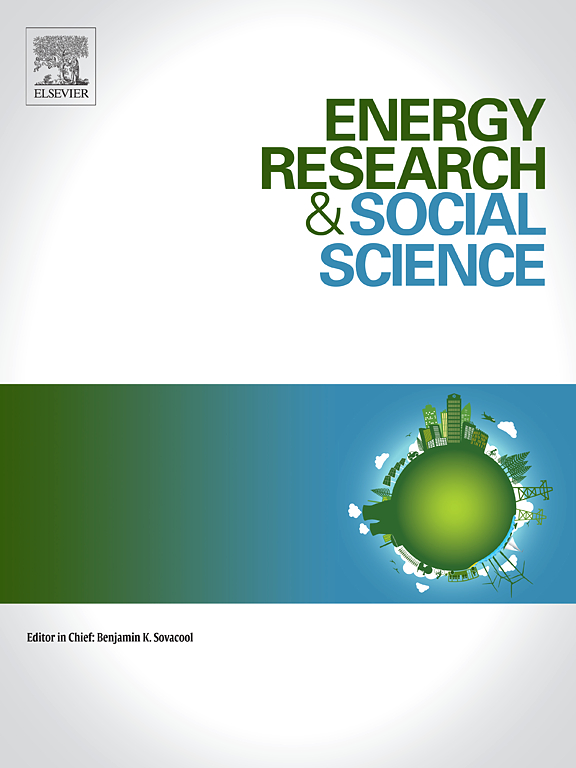Powering fairness in climate adaptation capabilities: Evaluating the influence of air conditioning rebates in a hot climate
IF 7.4
2区 经济学
Q1 ENVIRONMENTAL STUDIES
引用次数: 0
Abstract
Assisting households with maintaining adequate energy supply is one method for improving overall quality of life. Households experiencing energy insecurity may be unable to afford to use energy for necessary services at home (e.g., unable to purchase air conditioners). Energy efficiency (EE) can reduce energy costs for low-income households–requiring less energy for essential activities. While existing research has identified the groups that are less likely to participate in energy efficiency programs, there is limited research on how participation impacts energy insecurity among vulnerable households when they participate.
Using over 138,000 households in Tallahassee, Florida we study participants in a neighborhood program that targeted underserved communities. We conduct quasi-experimental difference-in-difference comparisons for seasonal energy consumption, energy bills, and energy burden during the cooling season in response to air conditioning (AC) appliance purchases. We compare impacts for households in the program (REACH) and higher income non-REACH qualified households.
We find that REACH homes, on average, save approximately 300kWh-eq on energy or $25 seasonally after purchasing an AC unit. While AC rebates reduce seasonal energy burden by 0.6 % in non-REACH homes, there is no statistically significant change in seasonal energy burden for REACH homes. The difference in energy reduction between REACH and non-REACH qualified homes could be due to increases in AC use among REACH homes after rebates. Further work could explore this trend of potential increases in efficient appliance use among low-income homes.
促进气候适应能力的公平性:评估炎热气候下空调返利的影响
帮助家庭维持充足的能源供应是提高整体生活质量的一种方法。经历能源不安全的家庭可能无法负担家用能源的必要服务(例如,无法购买空调)。能源效率(EE)可以降低低收入家庭的能源成本——基本活动所需能源减少。虽然现有的研究已经确定了不太可能参与能源效率计划的群体,但关于参与计划如何影响脆弱家庭的能源不安全的研究有限。我们调查了佛罗里达州塔拉哈西市的13.8万户家庭,研究了一个社区项目的参与者,该项目以服务不足的社区为目标。我们对季节性能源消耗、能源账单和冷却季节的能源负担进行了准实验差异比较,以响应空调(AC)电器的购买。我们比较了项目(REACH)家庭和高收入非REACH合格家庭的影响。我们发现,在购买空调设备后,REACH家庭平均节省约300千瓦时当量的能源或季节性节省25美元。虽然空调退税使非REACH家庭的季节性能源负担减少了0.6%,但REACH家庭的季节性能源负担没有统计学上的显著变化。REACH和非REACH家庭之间的节能差异可能是由于退税后REACH家庭中空调使用的增加。进一步的工作可以探索低收入家庭有效使用电器的潜在增长趋势。
本文章由计算机程序翻译,如有差异,请以英文原文为准。
求助全文
约1分钟内获得全文
求助全文
来源期刊

Energy Research & Social Science
ENVIRONMENTAL STUDIES-
CiteScore
14.00
自引率
16.40%
发文量
441
审稿时长
55 days
期刊介绍:
Energy Research & Social Science (ERSS) is a peer-reviewed international journal that publishes original research and review articles examining the relationship between energy systems and society. ERSS covers a range of topics revolving around the intersection of energy technologies, fuels, and resources on one side and social processes and influences - including communities of energy users, people affected by energy production, social institutions, customs, traditions, behaviors, and policies - on the other. Put another way, ERSS investigates the social system surrounding energy technology and hardware. ERSS is relevant for energy practitioners, researchers interested in the social aspects of energy production or use, and policymakers.
Energy Research & Social Science (ERSS) provides an interdisciplinary forum to discuss how social and technical issues related to energy production and consumption interact. Energy production, distribution, and consumption all have both technical and human components, and the latter involves the human causes and consequences of energy-related activities and processes as well as social structures that shape how people interact with energy systems. Energy analysis, therefore, needs to look beyond the dimensions of technology and economics to include these social and human elements.
 求助内容:
求助内容: 应助结果提醒方式:
应助结果提醒方式:


